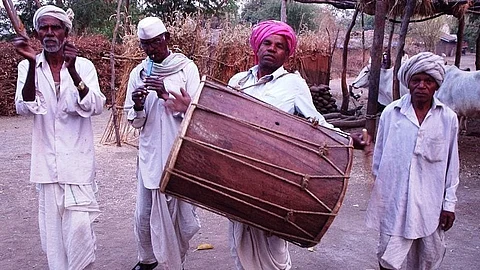

Despite significant development initiatives across Madhya Pradesh and Maharashtra, Adivasi communities living along the shared borders of the two states remain disproportionately affected by socio-economic challenges. Poverty, malnutrition and inadequate access to essential services such as education and healthcare continue to persist, revealing a stark contrast between the strides made in development and the realities faced by these indigenous populations.
The National Family Health Survey (NFHS-5), India’s family healthcare monitoring system, highlighted early substance abuse, including alcohol and tobacco use, as a significant concern in these areas. The survey found that over 50 per cent of the population in the border districts of Madhya Pradesh and Maharashtra started consuming these substances by the age of 15.
“This factor contributes to over 20 per cent loss of manpower efficiency among the labour force aged 18 to 40,” said officials from Maharashtra’s labour department.
Toilet availability remains low in these regions, with only 21 per cent of households having access to proper sanitation, compared to 93.5 per cent in urban areas, according to rights activist Pramod Mhatre, citing Panchayat Raj statistics.
Malnutrition is one of the most pressing concerns for Adivasis in these border areas. Data from NFHS-5 indicated that malnutrition among tribal children in Madhya Pradesh and Maharashtra is significantly higher than the national average.
In Maharashtra’s Nandurbar district, over 48 per cent of children under five were reported as stunted and 40 per cent as underweight, as of 2020. Severe acute malnutrition remains a concern, with many children suffering from wasting and related health issues.
In Madhya Pradesh, tribal children face similar challenges. A 2021 report from All India Institute Of Medical Sciences or AIIMS Bhopal found that 12-14 per cent of tribal children under five years suffered from some form of malnutrition.
While state and central initiatives such as the Integrated Child Development Services and the Pradhan Mantri Poshan Shakti Nirman scheme aim to address these issues, ground-level implementation often faces challenges such as supply shortages and irregular services in remote areas, according to statistics in the Tribal Area Development Programme document.
Malnutrition trends over the past five years show little improvement. Both stunting and wasting remain prevalent, exacerbated by poor access to nutritious food, inadequate maternal healthcare and insufficient infant feeding practices. Districts such as Barwani and Mandla in Madhya Pradesh report high rates of underweight children due to ineffective interventions and local governance issues.
Access to healthcare in the tribal areas of Madhya Pradesh and Maharashtra remains woefully inadequate. Primary healthcare centres (PHCs) in these regions are often underfunded, understaffed and located far from the villages.
Institutional delivery rates in tribal areas of Madhya Pradesh are much lower compared to urban areas. In Maharashtra’s Nandurbar district, while 79 per cent of households report access to improved sanitation facilities, only about 54 per cent have health insurance, according to Panchayat member Manohar Pendekar.
Anaemia is another serious health issue among Adivasi women and children. In Maharashtra’s tribal districts, such as Nandurbar, over 60 per cent of women aged 15-49 suffer from anaemia. In Madhya Pradesh, the situation is similarly alarming, with nearly 55 per cent of tribal women affected, contributing to poor maternal health and perpetuating malnutrition in children.
While national literacy rates are improving, tribal communities in these border areas lag behind. Data from NFHS-5 reveals that women from Scheduled Tribes in Maharashtra and Madhya Pradesh are significantly less likely to complete 10 years of schooling compared to the general population.
In Nandurbar, only 25 per cent of women have completed 10 or more years of schooling. Madhya Pradesh’s tribal areas report similar trends, with literacy levels notably lower among tribal women compared to men.
The lack of infrastructure, such as schools and qualified teachers, contributes to the disparity in educational attainment. Many Adivasi children drop out of school to help their families with agricultural labour, perpetuating the cycle of poverty.
Agriculture remains the primary livelihood source for Adivasis in these regions. “In the hilly areas, patches as small as one acre are used to grow spices, berries and collect minor forest produce (MFP) for sale in local markets,” explained a tribal representative.
Tribes like Kolam, Korku, Warli, Mahadeo Koli, Katkari, Thakar and Dhangars have formed working groups to monitor their economic gains from farming and MFP collection. However, attempts to form cooperatives have struggled due to complications with the forest department.
Small landholdings, unpredictable rainfall and a lack of access to modern farming techniques contribute to poor agricultural productivity. The 2021-2022 agricultural census shows that most tribal farmers in these areas are small-scale cultivators, struggling with low yields and poor soil conditions. Inadequate market access means many Adivasi families find it difficult to sustain themselves through farming alone.
Non-agricultural employment opportunities are sparse and many Adivasis migrate seasonally to cities or industrial towns in search of work, leading to socio-economic instability. Government schemes, such as the Mahatma Gandhi National Rural Employment Guarantee Act (MGNREGA), aim to improve livelihoods, but implementation gaps prevent many tribal families from fully benefiting.
Both Maharashtra and Madhya Pradesh have policies aimed at improving the socio-economic status of Adivasis, including the Tribal Sub-Plan (TSP) and targeted welfare schemes. However, their efficacy remains questionable. Health and education initiatives often fail to reach the most marginalised. For instance, while Nandurbar district in Maharashtra has been a focus area for development schemes, a lack of coordination between government departments often limits their impact.
In Madhya Pradesh, initiatives such as the Mukhyamantri Jan Kalyan Yojana and the Beti Bachao Beti Padhao programme have made some headway, but issues like child marriage and early pregnancies remain prevalent in some areas. Efforts to empower the girl child are minimal and school dropout rates remain high.